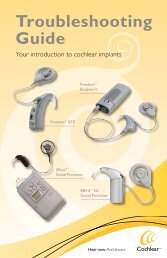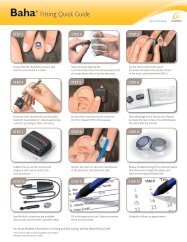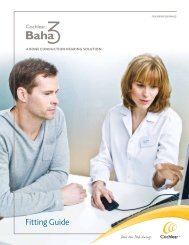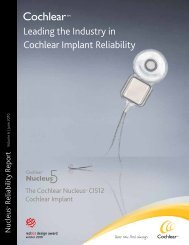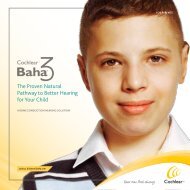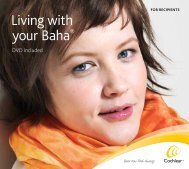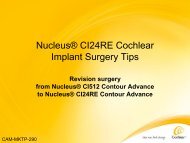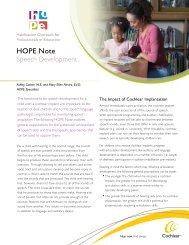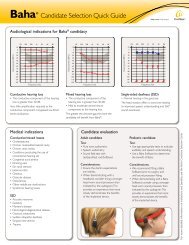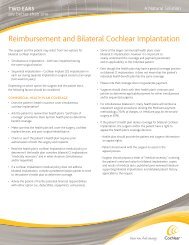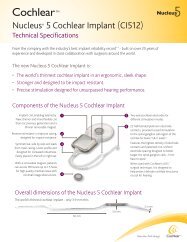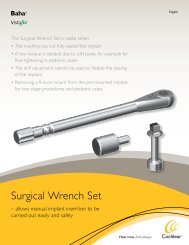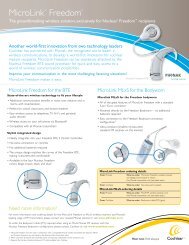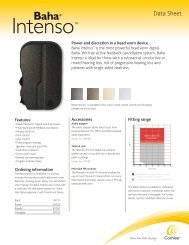Professional Quick Tips.pdf - For professionals - Cochlear Americas
Professional Quick Tips.pdf - For professionals - Cochlear Americas
Professional Quick Tips.pdf - For professionals - Cochlear Americas
Create successful ePaper yourself
Turn your PDF publications into a flip-book with our unique Google optimized e-Paper software.
Turn<br />
on<br />
the music<br />
TM<br />
<strong>Quick</strong> <strong>Tips</strong> for<br />
optimizing a recipient's<br />
experience with music
• SmartSound TM<br />
2 allows personalized customization to meet a<br />
recipient’s specific needs in optimizing music enjoyment<br />
• <strong>Cochlear</strong>’s Music Program which consists of a combination<br />
of ADRO ® + Whisper TM<br />
is the first choice recommended for<br />
listening to live or recorded music via any audio source.<br />
C<br />
T<br />
Programming Rehabilitation<br />
• How Does a Music Program Work?<br />
Sound "boosted" by ADRO<br />
Sound reduced by ADRO<br />
• Biological Factors<br />
- Presence of residual hearing 1<br />
- Length of profound sensorineural<br />
hearing loss<br />
- Age<br />
- Patent cochlea with full insertion<br />
1 Gfeller, Kate, Oleson, Jacob, Knutson, John F, Breheny, Patrick, Driscoll, Virginia, Olszewski, Carol; Multivariate<br />
predictors of music perception and appraisal by adult cochlear implant users; JAAA 19(1):120-134 Feb 2008<br />
2 Gfeller, Kate, PhD, F.Wendell Miller Distinguished Professor; Piecing the Puzzle Together; June 2008<br />
www.cochlear.com<br />
Music: Whisper TM + ADRO ®<br />
C Maximum comfort level T Threshold of audibility<br />
Whisper<br />
Whisper lifts quieter<br />
sounds into the<br />
audible range<br />
ADRO<br />
ADRO boosts dynamic<br />
signals (e.g. bass beat +<br />
vocal) while reducing those<br />
which are more constant<br />
Counseling Adult Recipients on Factors<br />
that Can Influence Music Appreciation<br />
• Realistic Expectations<br />
- Set realistic expectations; music<br />
may not sound like it did before the<br />
recipient’s hearing loss.<br />
- Capabilities vary with respect to music.<br />
Even people with normal hearing<br />
have personal music preferences<br />
and varying abilities for music<br />
While the Music Setting is our first recommendation<br />
for recipients to enjoy music, we recognize that music<br />
perception and enjoyment is unique for each environment<br />
and each individual. Custom Sound TM Suite software offers<br />
you the flexibility to customize music programs to meet each<br />
individual’s needs. You can create multiple Music programs, and<br />
encourage recipients to try using different MAPs when listening<br />
to music to see what works best. A recipients MAP can easily<br />
be customized for their individual needs, for example:<br />
- When using an iPod or other accessory, adjust the accessory<br />
mixing ratio to 10:1. Remember, this will change the IIDR<br />
from 40 to 30 dB.<br />
- SmartSound Focus is an excellent choice for recipients who<br />
want to hear music and their dance partner<br />
- The default Music map incorporates Whisper + ADRO<br />
technology. Experiment with the other options in the Music<br />
environment as well: Autosensitivity TM + ADRO and ADRO.<br />
Each option works in slightly different ways.<br />
o Whisper + ADRO: Whisper boosts the level of soft<br />
signals without increasing loud sounds. The ADRO<br />
component then dynamically optimizes the level of signals<br />
in each channel.<br />
o ASC + ADRO: ASC minimizes the effects of noise in the<br />
changing acoustic environment, then ADRO dynamically<br />
optimizes the level of signals in each of up to 22 channels.<br />
o ADRO: An input processing algorithm designed to make<br />
soft sounds more audible while maintaining comfort for<br />
loud sounds in dynamic environments.<br />
• Listening Conditions<br />
- Recipients should avoid music played<br />
at a loud volume<br />
- Recipients should avoid listening<br />
conditions where there<br />
is a lot of echo or competing noise<br />
• Research suggests that with practice and training CI recipients do<br />
report improvements in music performance and enjoyment. 2<br />
- Ask an AV therapist for ideas.<br />
- Take a music class<br />
- Learn the scales<br />
• Practice, Practice, Practice. Patience, persistence, practice and<br />
a positive attitude will go a long way!<br />
• If the recipient wears a hearing aid in the unimplanted ear,<br />
encourage hearing aid use when listening to music as it can<br />
improve the sound quality.<br />
• Recipients should start by choosing familiar music like lullabies<br />
or the birthday song. Use simple melodies in the beginning and<br />
stay away from harmonized complex tones of classical music.<br />
• Encourage them to listen to some of their old favorites over<br />
and over and over again! Sound quality will improve over<br />
time. It’s a great idea to experiment with different types of<br />
music from classical, soft rock, pop, country, etc. Recipients<br />
can go to a music store to sample the music. Most music<br />
What Helps Children Enjoy Music<br />
• Listen in quiet environments with good acoustics<br />
• Keep the music volume down<br />
• Obtain the words to songs and teach them to the child<br />
before playing the music<br />
• Certain kinds of music or instruments may be more enjoyable<br />
• Try different kinds of music<br />
• Try different music activities:<br />
- Listening to music<br />
- Moving to music<br />
- Singing<br />
- Playing musical instruments<br />
• Watch how the child responds to music and take cues<br />
from them<br />
stores provide headsets that can be placed over the<br />
processor or an accessory can be plugged into their audio jack.<br />
- Many recipients enjoy country and rock due to the<br />
strong beat<br />
- <strong>Cochlear</strong> implants transmit rhythm (beat), timbre (tone),<br />
and lyrics effectively<br />
- Hearing individual notes and melodies are more challenging.<br />
• Encourage recipients to sample songs for free before<br />
purchasing them at the iPod iTunes website.<br />
• Understanding the lyrics will be difficult. Encourage recipients<br />
to have the lyrics in front of them to follow along. Lyrics can<br />
be printed from the internet by “googling” the song name.<br />
• Encourage recipients to have a partner “sing along” with the<br />
song so they can lip read and learn placement of lyrics.<br />
• Ask recipients to keep a log of their progress. It will give you<br />
an idea of what’s working, what’s not working, and how<br />
they are progressing.<br />
• Remind recipients to relax and have fun as they explore the<br />
world of music with their cochlear implant.<br />
Conclusions<br />
• Many children enjoy informal music activities (i.e., sing<br />
alongs, etc.)<br />
• Some children may ask for a formal music experience<br />
(i.e., taking lessons)<br />
• Capabilities vary with children<br />
• Know that certain activities and music styles may be difficult<br />
• If they enjoy it – regardless of their skill or ability – go for it!
Accessories<br />
• Adjustment of the mixing options for accessories.<br />
- Trial different ratios depending on patient preference<br />
• Try accessories that provide direct input<br />
- Nucleus Personal Audio Cable (PAC) to iPod or any<br />
MP3 player<br />
- Nucleus TV/HiFi Cable with stereos, TV, & computers<br />
- Silhouettes: Hatis, Noiz-Free, etc<br />
- Headphones<br />
Additional Resources<br />
• UW-CAMP: Order from website, $150.00 http://depts.washington.edu/<br />
ventures/UW_Technology/Express_Licenses/CAMP.php<br />
• Kimberly Sena, Jenny Rogers Kruse, Carol Olszewski and Kate Gfeller “Music<br />
Enjoyment and Activities for Children with <strong>Cochlear</strong> Implants.” CONTACT.<br />
2001, Vol 15, No 1-2, pg 11-14<br />
• Fujita, S. and Ito, J. (1999). Ability of nucleus cochlear implantees to<br />
recognize music. Annals of Otology, Rhinology and Laryngology<br />
108: 634-640.<br />
• Gfeller, K. (2001). Aural rehabilitation of music listening for adult cochlear<br />
implant recipients: Addressing learner characteristics. Music Therapy<br />
Perspectives, 19, 88-95<br />
• Gfeller KE, “Accommodating children who use cochlear implants in the<br />
music therapy or educational setting.” Music Therapy Perspective. 2000, Vol<br />
18, No 2, pg 122-130<br />
• Gfeller, KE, Mehr M, Witt S, “Aural rehabilitation of music perception<br />
and enjoyment of adult cochlear implant users.” Journal of Academy for<br />
Rehabilitative Audiology. 2001, Vol 34, pg 17-27<br />
• Gfeller, K., and Lansing, C. R. (1991). Melodic, rhythmic, and timbral<br />
perception of adult cochlear implant users. Journal Speech Hearing<br />
Research. 34, 916-920.<br />
• Gfeller, K. and Lansing C.R. (1992). Musical perception of cochlear implant<br />
users as measured by the primary measures of music audiation: An item<br />
analysis. Journal of Music Therapy, 29: 18-39.<br />
• Gfeller, K., Woodworth, G., Robin, D. A., Witt, S., and Knutson, J. F. (1997).<br />
Perception of rhythmic and sequential pitch patterns by normally hearing<br />
adults and adult cochlear implant users. Ear & Hearing, 18, 252-260.<br />
www.cochlear.com<br />
<strong>Cochlear</strong> <strong>Americas</strong><br />
13059 East Peakview Avenue<br />
Centennial, CO 80111 USA<br />
Tel: 1 303 790 9010<br />
Fax: 1 303 792 9025<br />
Toll Free: 1 800 523 5798<br />
• HOPE Music Series:<br />
- <strong>Tips</strong> for Improving Music Listening Skills<br />
- Nucleus Sound Processor Accessories Guide<br />
- Music and Implants: Piecing the Puzzle Together<br />
Author: Kate Gfeller, and F. Wendell Miller,<br />
Iowa <strong>Cochlear</strong> Implant Clinical Research Center,<br />
University of Iowa<br />
• Sound and Way Beyond<br />
• www.cochlearamericas.com/turnthemusicon<br />
Visit www.cochlear.com/hope to view all of our latest educational tools and materials<br />
Website: www.cochlearamericas.com/turnthemusicon<br />
FUN963 ISS1 JAN09<br />
Music Resources from <strong>Cochlear</strong><br />
• Gfeller, K., Knutson, J. F., Woodworth, G., Witt, S., and DeBus, B. (1998).<br />
Timbral recognition and appraisal by adult cochlear implant users and<br />
normal-hearing adults. Journal American Academy of Audiology, 9, 1-19.<br />
• Gfeller, K., Christ, A., Knutson, J. F., Witt, S., Murray, K. T., and Tyler, R. S.<br />
(2000). Musical backgrounds, listening habits, and aesthetic enjoyment of<br />
adult cochlear implant recipients. Journal American Academy of Audiology,<br />
11, 390-406.<br />
• Leal MC, Shin YJ, Laborde ML, Calmels MN, Verges S, Lugardon S, Andrieu<br />
S, Deguine O, Fraysse B. (2003). Music perception in adult cochlear implant<br />
recipients. Acta Otolaryngology, 123(7):826-35.<br />
• Mirza, S., Douglas, S. A., Lindsey, P., Hildreth, T., and Hawthorne, M. (2003).<br />
Appreciation of music in adult patients with cochlear implants: a patient<br />
questionnaire. <strong>Cochlear</strong> Implants International, 4 (2), 85-95.<br />
• Kong, Y-Y., Stickney G.S., Zeng F-G. (2005): Speech and melody recognition<br />
in binaurally combined acoustic and electric hearing. Journal of Acoustical<br />
Society of America, 117 (3), 1351-1361<br />
• Pijl, S., and Schwarz, D. W. F. (1995). Melody recognition and musical interval<br />
perception by deaf subjects with electrical pulse trains through single<br />
cochlear implant electrodes. Journal of Acoustical Society of America,<br />
98, 886-894.<br />
• Pijl, S., and Schwarz, D. W. F. (1995). Intonation of musical intervals by deaf<br />
subjects stimulated with single bipolar cochlear implant electrodes. Hearing<br />
Research, 89, 203-211.<br />
• Pijl, S. (1997). Labeling of musical interval size by cochlear implant patients<br />
and normally hearing subjects. Ear & Hearing, 18, 364-372.



